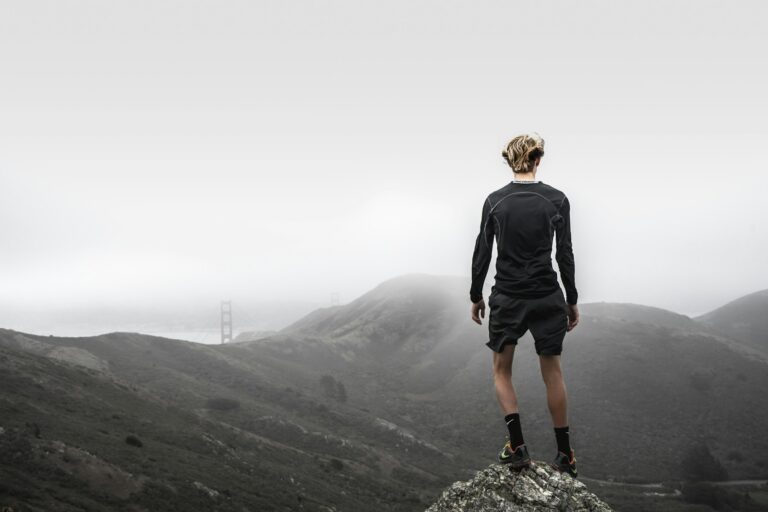I’ve always believed in the power of trail running for anxiety relief. It’s fascinating how a simple act like running can significantly impact our mental health. Specifically, trail running has emerged as a remarkable strategy for managing anxiety and stress.
The Anxiety and Depression Association of America highlights the mental clarity and concentration benefits that come with regular physical activity. But there’s something uniquely therapeutic about trail running. It’s not just the exercise; it’s the immersion in nature, the varied terrain, and the break from the monotony of our daily routines that work together to refresh our mental state. Let’s dive into how hitting the trails can be your next step towards anxiety relief.
Benefits of Trail Running for Anxiety Relief
When I think about the ways to combat mental illness, trail running always stands out as a holistic approach. Not only does it offer a physical outlet for stress, but it also provides significant overall mental health benefits. Let’s delve deeper into how hitting the trails can alleviate anxiety.

Physical Benefits
First and foremost, the physical benefits of trail running are undeniable. As I lace up my shoes and hit the trails, my body undergoes a remarkable transformation. The varied terrain of trail running strengthens muscles that might not be engaged during road running, offering a comprehensive workout that challenges my body in new and exciting ways. Not only does this improve cardiovascular health, but it also enhances endurance and flexibility.
But there’s more to it than just getting a good workout. The act of trail running increases the production of endorphins, known as the body’s natural mood lifters. This biochemical process is crucial for those of us grappling with anxiety, providing a natural and effective form of relief. Furthermore, regular physical activity, such as trail running, improves sleep quality by increasing the amount of melatonin the body produces, thus creating a positive cycle of physical health benefits that directly impact anxiety levels.
Mental Benefits
On the mental side of things, the therapeutic benefits of trail running are just as impactful. Immersing myself in nature, away from the hustle and bustle of daily life, grants me a sense of peace and tranquility that’s hard to find elsewhere. This connection with nature is not just anecdotal; numerous studies highlight the positive effects of spending time outdoors on mental well-being.
Trail running also serves as a form of moving meditation. The focus required to navigate the uneven terrain helps center my thoughts, pushing away anxiety-inducing worries and stress. This heightened state of mindfulness results in a clearer mind and a more positive outlook on life.
Moreover, the sense of accomplishment that comes from completing a challenging run boosts confidence and self-efficacy, proving to myself that I can overcome obstacles, both physical and mental health trail running. This boost in self-esteem is crucial for anyone dealing with anxiety, as it reinforces the belief in one’s own capabilities and resilience.
In essence, the benefits of trail running for anxiety relief are multifaceted, addressing both physical and mental health in a balanced and effective way. As I continue to explore the trails, I’m not just running from my anxiety—I’m running towards a healthier, more centered version of myself.
How to Start Trail Running
Embarking on a trail running journey is an exciting step towards enhancing both your physical health and mental well-being. I’ve gathered some essential information to help you start off on the right foot.
Essential Gear
When it comes to trail running, the right gear can make all the difference. I’ve discovered that investing in a pair of quality trail running shoes is crucial. These shoes are specifically designed with better grip and support to handle uneven terrain, reducing the risk of slips and injuries. I always look for ones with a sturdy sole and decent water resistance, especially for those dewy morning runs.
In addition to shoes, I recommend lightweight, moisture-wicking clothing to keep you comfortable during your run. The right outfit should help manage your body temperature and prevent chafing. Don’t forget a supportive hydration pack or belt, especially for longer distances. Keeping hydrated is key to maintaining your stamina and focus.
Lastly, a good trail running watch with GPS functionality can be a game changer. It’s not just about tracking your distance or pace; it’s about exploring new trails with confidence. I always make sure mine is fully charged before heading out.
Safety Tips
Trail running presents unique challenges and safety considerations. Here are a few tips I’ve learned along the way to ensure a safe experience:
- Start Slow: If you’re new to trail running, gradually increase your distance and intensity. This approach helps your body adjust and can prevent overuse injuries.
- Be Weather-Wise: Always check the weather forecast before a run. Sudden changes can affect trail conditions and your safety.
- Let Someone Know: Before heading out, I make it a point to inform someone about my running location and estimated return time. It’s a simple step that can be crucial in case of an emergency.
- Stay on Marked Trails: To mitigate the risk of getting lost, I stick to well-marked trails, especially when exploring new areas. Venturing off the designated path can lead to dangerous situations.
- Carry Essentials: My pack always includes water, some form of nutrition like energy bars, a first-aid kit, a map or compass (even if my watch has GPS), and my phone fully charged. It’s better to be over-prepared than underprepared.
By embracing these foundational steps and precautions, I’ve found that trail running is not only an effective tool for anxiety relief but also an incredibly rewarding outdoor adventure. Whether you’re seeking solitude in nature or an adrenaline-filled exploration, trail running can cater to various needs and preferences. Remember, it’s about personal progress and enjoying the journey, not just the destination.
Finding the Right Trail
When embarking on the journey of trail running especially for anxiety relief, selecting the right trail can significantly enhance the experience. I’ve discovered that not all trails are created equal, and finding one that resonates with your needs and preferences is key to making the most of your runs. Let’s delve into the aspects of scenic locations which I believe are fundamental in choosing your trail.

Scenic Locations
One of the main reasons I advocate for trail running is the immersion in nature’s beauty. The serenity and scenic vistas can have a profound impact on mental well-being, making scenic locations my top priority when selecting a trail. Here’s why:
- Natural Beauty: Trails that offer breathtaking views, whether it’s a panoramic mountain vista, a peaceful forest, or a serene lake, provide an instant sense of calm and joy. These sights can divert your mind from daily stresses and foster a deep connection with nature.
- Diversity of Landscapes: I look for trails that showcase a variety of landscapes within a single run. This diversity not only keeps the run interesting but also stimulates the mind in positive ways, helping to combat anxiety.
- Wildlife Encounters: Trails frequented by wildlife add an extra layer of excitement to your runs. Observing animals in their natural habitat can be a thrilling and grounding experience, reminding us of the simplicity and beauty of life.
When choosing a scenic trail, it’s important to consider your own comfort level and physical ability. While a rugged mountain path might offer stunning views, a more accessible forest trail might be more enjoyable if it matches your fitness level and experience.
Additionally, keeping safety in mind is crucial. Always research the trail conditions before heading out and choose trails that are well-marked and frequented by other runners or hikers. This ensures you can relax and fully immerse yourself in the scenery without worrying about getting lost or encountering unsafe conditions.
In my trail running adventures, I’ve found that the right scenic location can transform a routine workout into a rejuvenating escape, significantly enhancing the therapeutic benefits of the run. Whether you’re a seasoned trail runner or new to the sport, taking the time to find scenic trails that speak to your soul can make all the difference in your journey toward anxiety relief.
Embracing trail running as a means to combat anxiety isn’t just about physical activity; it’s about immersing yourself in nature’s embrace. By carefully selecting a trail that resonates with your soul, you’re not just running; you’re healing. Remember, it’s the harmony of scenic beauty, personal comfort, and safety that transforms a simple run into a powerful antidote to anxiety. So lace up your shoes, step onto the trail, and let every stride take you closer to tranquility. Trust me, it’s a journey worth embarking on.
Frequently Asked Questions
What exercise is best for anxiety?
Any form of exercise that improves cardiovascular health can help with anxiety. Options include running, swimming, biking, and brisk walking. These activities help in reducing anxiety by improving oxygen delivery throughout the body.
Is it good to run every day if you have anxiety?
Yes, regular aerobic exercise, particularly jogging, can significantly reduce the symptoms of clinical depression and anxiety, according to the Anxiety and Depression Association of America. Exercise like running can help in managing anxiety symptoms and promoting relaxation.
How does running change body shape?
Running primarily targets the legs, affecting the quadriceps, hamstrings, calves, and hip flexors. These muscles work in unison during running, leading to increased strength and definition over time. Running regularly can lead to a more toned and fit body shape.
Is trail running a neuromuscular exercise?
Yes, trail running poses a higher challenge to the neuromuscular system than road running. It requires greater muscle coordination, proprioception, and activation due to the varying and often uneven terrain encountered on trails.
Why is running calming?
Running helps to blunt the brain’s response to physical and emotional stress. It encourages the release of endorphins, which are feel-good hormones that can improve mood and heart health, offering calming effects similar to those of certain medications used for managing anxiety.
